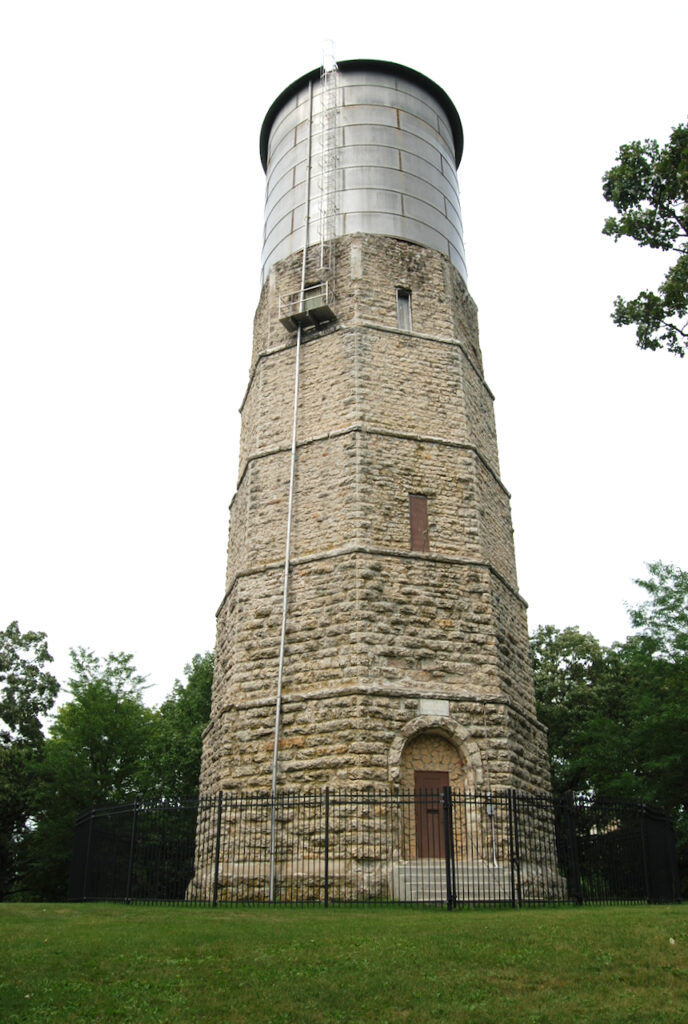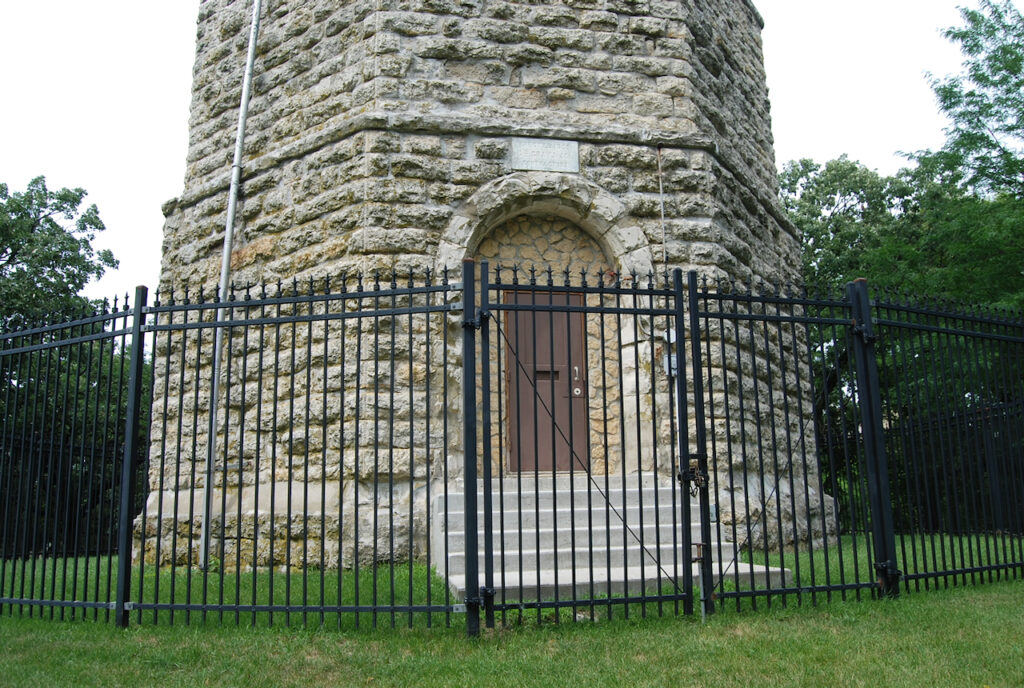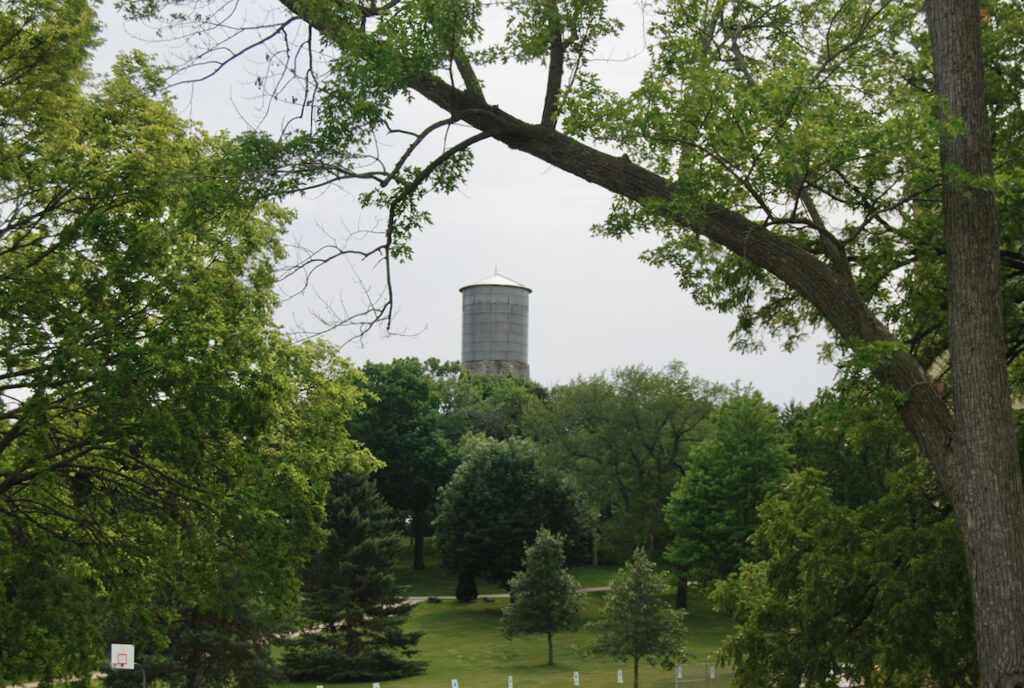Correction: During public comments at Tuesday’s meeting, Kori Oberle asked Cornerstone to provide the cost of demolition, and not costs associated with moving the tower. Copy has been changed to reflect her statement. Fort Atkinson Online regrets the error.
By Chris Spangler
The Whitewater Common Council on Tuesday kicked off a community conversation about what to do with the historical Starin Park water tower.
The tower, which was built in 1889 by C.E. Gray Jr. and Co., according to lettering engraved on its datestone, is located in the city’s Starin Park.
As of 2020, freestanding informational signage in the park states, the tower “is the second oldest operating municipal water tower in the state of Wisconsin.”
The full tower’s height consists of 80 feet of stonemasonry which supports a 20-foot-tall water tank. The tank holds 185,000 gallons of water, informational signage states.
During Tuesday’s meeting, those in attendance learned that the city’s new southwest water tower will go online in 2023, so plans call for decommissioning the Starin Park tower in 10 to 12 months.
Department of Public Works Director Brad Marquardt reported that earlier this year, Cornerstone Restoration of Sullivan had undertaken some tuckpointing on the worst sections of the water tower to help stop leaking and deterioration of the structure’s interior.
The idea was to address falling material inside the tower, since employees enter the tower each day to take water samples.
Kyle O’Brien of Cornerstone told the council during its meeting Tuesday that his company did damage containment.
“We plugged a lot of holes with close to 3,000 pounds of mortar,” he said, noting that they “were patching what nature had opened.
“There is substantial work out there that still needs to be done,” he added.
The tower’s base is about 8 feet thick and the top is approximately 4 feet thick, O’Brien said.
“There’s a lot of mass there,” he said, telling the council that the tower “definitely needs a lot of attention.”
While Cornerstone was doing the work, O’Brien offered to provide a quote on what it would cost to restore the water tower. The estimate came in at $968,800.
He told the Public Works Committee last month that the work would include removing loose exterior face stone masonry veneer at the top two levels and replacing the salvaged stone. New stone exceeding three tons would boost the cost.
The bottom three sections would be fully tuckpointed at all elevations. Stone repairs on the lower three sections would be completed as needed on a time-and-materials basis of $105 per manhour.
The tank would have to be drained independently and remain empty throughout the project.
The proposal would only cover work to the face veneer. The interior stone backup wall was not evaluated.
Council President Lisa Dawsey Smith said Tuesday that she is certain nobody wants to see the old water tower razed, but she acknowledged that restoration is costly.
She said she recently received an email from Kori Oberle, a member of the city’s Landmarks Commission, who noted how Fort Atkinson restored its 1901 water tower through fundraising. While owned by the city, it was overseen by the Historic Preservation Commission until the Hoard Historical Museum assumed stewardship last August.
Oberle served as director of the museum from 2008-14.
Dawsey Smith said that even were the historical society to take responsibility for a Starin Park water town project, the issue of financing a restoration “doesn’t go away.”
The Landmarks Commission did discuss this at its last meeting, she added.
During public comments, Oberle posed several questions to O’Brien. Among then, she asked for the cost associated with demolishing the tower.
Within the discussion, O’Brien addressed the potential for salvaging materials from the tower.
“As far as the stone itself, the exterior stone, some of it has shale split and peeled off … Presumably the interior stone is in better shape, but it is encapsulated in mortar, so whether it could be reutilized in another project or not is a factor,” O’Brien said.
Oberle noted that the Jeffers Family Foundation in Janesville would be a likely funding source for a tower restoration, and that the structure meets preliminary eligibility requirements.
“I think the big question is how much is it going to cost to save it?” she said. “But a bigger question is what would the community do with it once its saved? It’s what you’ve been asking all along. Who would be responsible for it and how would we keep it in better repair so this wouldn’t happen again?”
Citizen Richard Helmick asked whether draining the water tank might positively impact the immediacy of repair.
“The compressive load of the water itself helps solidify the structure and helps overcome ice jacking or steel jacking. Whether the interior would deteriorate faster without the load on it, I would say it would be somewhat negligible,” O’Brien replied.
Ice jacking occurs when water permeates a confined space within a structural support, ultimately causing structural fracture when the water freezes and expands.
He said there is a lot of steel up there, so there still will be a lot of weight even if the water tank is empty.
Whitewater resident Dave Saalsaa likened the tower’s structure to that of the Egyptian pyramids.
“The pyramids in Egypt have a capstone of limestone over big stones. That capstone fell off, the pyramids are still there,” he told the council. “Are you saying the capstones are the ones in danger of falling off? We don’t really know what the interior looks like because it’s still covered up by capstones, correct?”
O’Brien said it is not just the capstones — or courses, as they are called technically when brick and mortar are sandwiched together — that are a concern.
“There’s all these difference courses and they interlock. The capstones might be where it steps back. Those themselves are losing some shale. But the veneer itself — the masonry, exterior of the building, the stuff you see as the veneer — those sections also are shaling, falling off, as well. So it is the whole structure, not just specific section …,” he said.
City Manager Cameron Clapper also offered remarks.
“We have a tower here that is one of the oldest in the state of Wisconsin and something that we ought to dedicate more time and resources to discussing and determining the best course of action for it,” he said.
Clapper recommended providing Marquardt with anything needed for moving toward taking the Starin Park water tower out of service, as well as direction or action regarding having, with the Landmarks Commission, the historical society review potential funding resources, including the Jeffers Family Foundation.
“I know we don’t have as robust a community foundation as Fort Atkinson has, but community foundations are also a wonderful resource to utilize, at the very least, to solicit funds when we do fundraising projects and dedicate time and effort to what we can do,” the city manager said. “It would be a shame to simply act to remove the tower because the cost at this time is seemingly prohibitive. I think that there are people that really don’t want to pay taxes that would be happy to fund a project like this if they saw direct result in the end in having the tower still standing as a landmark.”
Marquardt said he did not need any immediate recommendations on decommissioning the tower.
Councilperson Jill Gerber wondered whether wrapping the tower would help stave off deterioration were work to be delayed for, say, three years. She also said she would like to know the cost of razing the structure.
Dawsey Smith said she would be interested in having the Landmarks Commission explore potential ownership options for the tower once the Water Department relinquishes responsibility.
She also said she would like to know if the Landmarks Commission would be amenable to providing summaries of potential funding avenues that could be pursued, especially the Jeffers Family Foundation.
In addition, she asked that this be routed to the Finance Committee to see if there might be potential future funding by the city.
Councilperson Brienne Diebolt Brown suggested also looking into the availability of federal monies.
Whitewater Landmarks Commission Chairperson Patricia Blackmer reminded the council that the city already is responsible for several landmarks, including the Birge Fountain, which is targeted for possible restoration by 2027.
“There are many, many things out there, and financing will be a problem because I know our budget is not that big,” she said. “But we’re looking at constantly reminding you that these are essential. The same with the effigy mounds preserve; that is an expense. Keep it tucked in your hat that there are other projects that the city is responsible for.”
She added, “I just want to remind the public, as well as the common council, that this is a local landmark and it is protected by ordinance.”
In other business, the council:
• Assigned a 15-minute parking stall in front of K9 Hair Care LLC at 104 W. Center St.
Owner Lisa Berglin had requested the change so her customers would be for easy dropoff and pickup of pets.
The Public Works Committee had recommended the 15-minute parking designation for 8 a.m. to 4 p.m. Monday through Friday. However, councilman Allen suggested removing the limited hours, adding that the 15-minute parking also would be beneficial to Gus’ Pizza drivers.
On a motion by Allen that was seconded by Diebolt Brown, the 15-minute stall was approved with no time or day limitations.
It is the first stall on the north side of Center Street, just west of Whitewater Street.
• Accepted the bid of FJA Christiansen Co. Inc. for the Digester Control Building roof replacement.
The Milwaukee company bid $91,456.

A view of the 1889-built water tower as it stands today in the city of Whitewater’s Starin Park. The tower, which is an active component of the city’s water utility system, will be decommissioned in 2023.

A doorway allows entrance into the 1889-built water tower. City employees enter the tower daily to take water samples, Whitewater Common Council members learned during their meeting held Tuesday.

Engraved lettering on the tower notes that it was built in 1889 by C.E. Gray Jr. and Co. Informational signage in Starin Park notes that the company was Chicago-based. The tower, according to the signage, was built initially as a private utility and turned over to the city in 1912. The octagon-shaped structure is constructed largely of limestone.

Nestled within the city of Whitewater’s Starin Park, the 1889-built stonemasonry water tower looms large above the treetops. According to informational signage in the park, the 100-foot-tall tower was built at the site because it is 50 feet higher than the surrounding area. The tower, which, as of 2020, is the second older municipal tower operating in Wisconsin, holds 185,000 gallons of water.
Kim McDarison photos.
This post has already been read 4987 times!

Might it be a possibility that there are members of our community that have talent in the needed area of these restorations, would possibly donate their labor if materials were supplied?